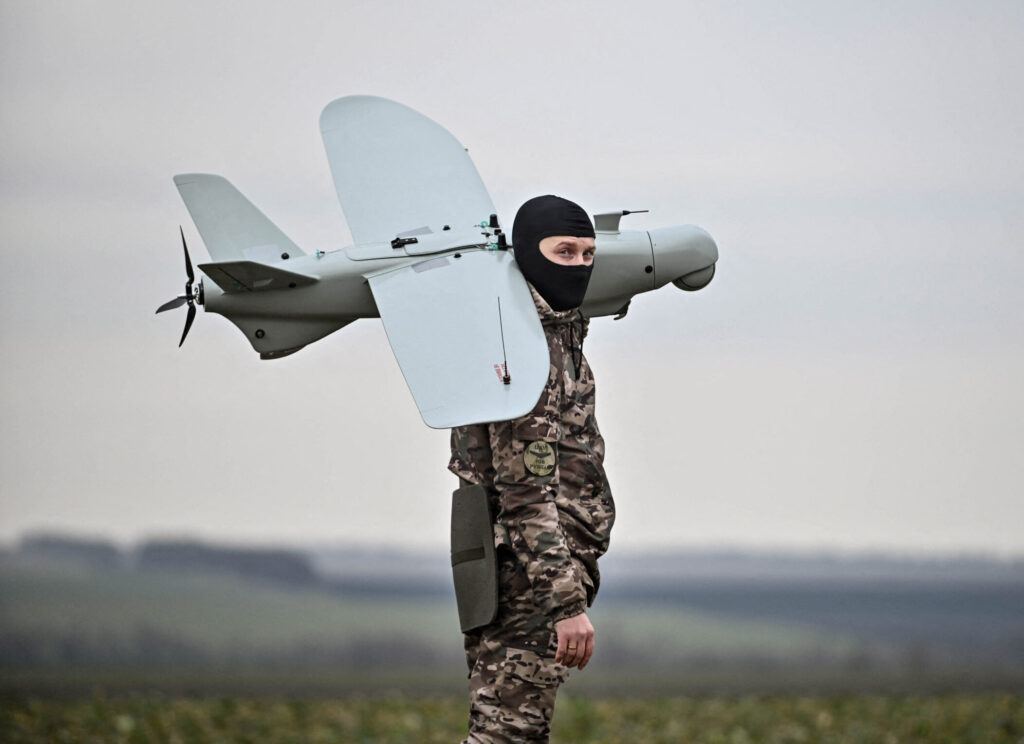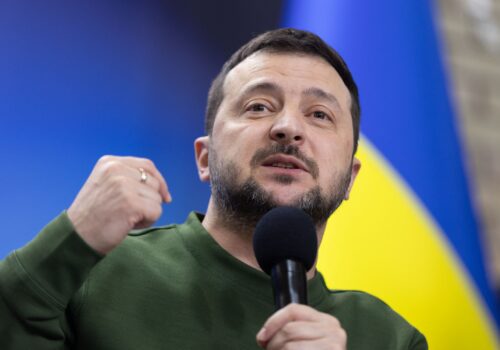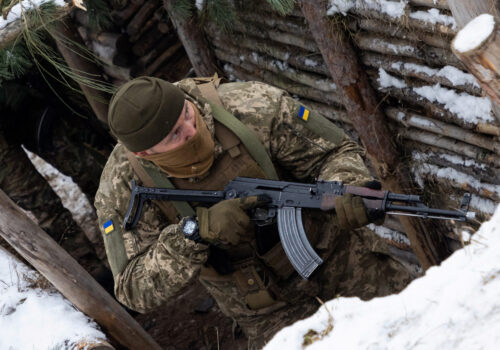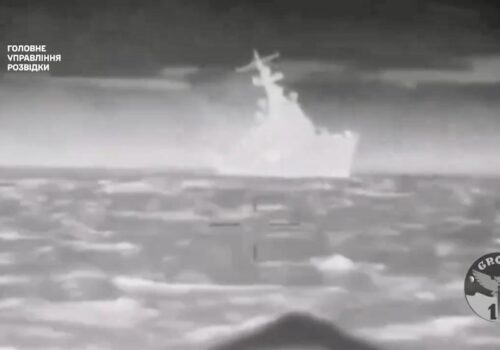
Outgunned Ukraine bets on drones as Russian invasion enters third year
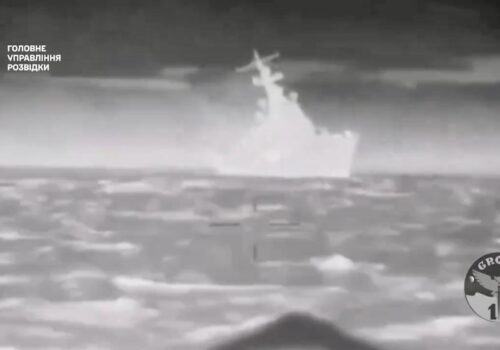
In early February, Ukrainian President Volodymyr Zelenskyy announced the creation of a separate branch of the Ukrainian Armed Forces devoted to drones. Ukraine’s new Unmanned Systems Force is a military innovation reflecting the growing prominence of drones in modern warfare. Zelenskyy’s decision also underlines the importance of UAVs to the Ukrainian war effort as Kyiv seeks to maintain a technological edge over Russia while grappling with mounting shortages in artillery shells and other more traditional weapons systems.
Russia’s full-scale invasion of Ukraine is not the first conflict to feature unmanned aerial vehicles in significant numbers. Reconnaissance and strike UAVs were employed extensively in eastern Ukraine following the onset of Russian aggression in 2014, and in a range of other combat zones over the past decade including Syria, Libya, and the Second Karabakh War in the southern Caucasus. Nevertheless, the unprecedented numbers of UAVs used by both sides over the past two years in Ukraine has led some to call Russia’s invasion the world’s first drone war.
The ubiquity of drones in Ukraine is leading to dramatic changes on the battlefield. Fleets of UAVs have revolutionized surveillance, making it extremely difficult for commanders to benefit from the element of surprise. This helps to explain why both the Russian and Ukrainian armies are finding it increasingly difficult to mount successful offensives against defensive positions. In addition to dramatically enhancing battlefield visibility, drones also serve as precision strike weapons capable of replicating many of the functions performed by artillery and missiles at only a fraction of the price.
Stay updated
As the world watches the Russian invasion of Ukraine unfold, UkraineAlert delivers the best Atlantic Council expert insight and analysis on Ukraine twice a week directly to your inbox.
Over the past two years, the Ukrainian military has managed to incorporate drones with considerable success. This has often been done on a somewhat improvised basis, with separate UAV teams independently established as part of different units. Ukraine’s expanding drone capabilities have owed much to public fundraising efforts and contributions from diverse grassroots groups including volunteer networks. Meanwhile, a startup-style drone manufacturing and modification industry has emerged from within Ukraine’s vibrant tech industry.
The results have been impressive. During a single week in early 2024, Ukrainian Minister of Digital Transformation Mykhailo Fedorov reported that the country’s drone units had destroyed 73 Russian tanks along with air defense systems, fuel storage depots, and multiple other high-value targets. Longer range drones are now being used to strike strategic targets deep inside Russia including military production sites and energy industry infrastructure. At sea, marine drones have helped break the Russian naval blockade of Ukraine’s Black Sea ports and have forced the bulk of Putin’s fleet to retreat from Crimea.
Much of this has been possible thanks to expanding domestic production. According to Ukrainian Prime Minister Denys Shmyhal, by early 2024 there were approximately 200 companies producing drones in Ukraine, with domestic output around one hundred times higher in 2023 than during the first year of Russia’s full-scale invasion. As manufacturing potential continues to expand, Ukrainian officials have set a target of more than one million domestically produced drones in 2024.
Ukraine’s international partners are also focusing their efforts on helping the country stay one step ahead of Russia in the drone war. A coalition of around ten countries recently vowed to deliver one million drones to Ukraine by February 2025, while France is reportedly preparing to provide the Ukrainian military with the latest strike drone models in the coming weeks.
Eurasia Center events

Ukraine’s newly established Unmanned Systems Force must now manage this highly dynamic drone supply situation while making sure the country’s expanding UAV fleets are deployed effectively in what is a rapidly changing battlefield environment.
The creation of a separate branch of the armed forces dedicated to drones should allow Ukraine to assess developments in a systematic manner and gain an accurate overview of the most effective tactics, making it possible to create something approaching a drone warfare doctrine. This would represent a considerable improvement on today’s somewhat chaotic approach to sharing experience, which often relies on direct communication between individual drone pilots and unit commanders.
The Unmanned Systems Force could take the lead in developing a more coordinated approach to training. At present, many of Ukraine’s UAV training programs are private initiatives that typically offer valuable insights but lack any centrally established standards. Additionally, the new branch can contribute to more effective cooperation with the military industrial complex to make sure Ukrainian manufacturers are focused on producing the kinds of drones the military needs.
Zelenskyy’s decision to establish a specific drone branch of the army also creates a number of potential challenges. Ukraine’s drone warfare evolution over the past two years has often been organic in nature. On many occasions, creative solutions have been implemented with a high degree of operational flexibility by people on the front lines of the conflict. Ukrainian commanders must now make sure efforts to coordinate the country’s drone operations do not blunt this creativity or slow down reaction times by introducing new layers of bureaucracy.
There is also a danger that efforts to fill leadership and training positions within the Unmanned Systems Force could lead to the withdrawal of experienced pilots from the combat zone. One solution might be to prioritize the recruitment of wounded drone operators who are not currently able to serve in front line conditions but have valuable knowledge to share.
The Russian invasion of Ukraine has turned the country into a giant war lab and confirmed the status of drones as the weapons of the future. With Ukraine no longer assured of further military aid from the US and increasingly obliged to ration ammunition, drones are a cost-effective solution that plays to the country’s tech sector strengths. President Zelenskyy and his military leaders clearly recognize this, and will be hoping the new Unmanned Systems Force can help Ukraine maximize its drone potential without becoming a bureaucratic burden.
Mykola Bielieskov is a research fellow at the National Institute for Strategic Studies and a senior analyst at Ukrainian NGO “Come Back Alive.” The views expressed in this article are the author’s personal position and do not reflect the opinions or views of NISS or Come Back Alive.
Further reading
The views expressed in UkraineAlert are solely those of the authors and do not necessarily reflect the views of the Atlantic Council, its staff, or its supporters.

The Eurasia Center’s mission is to enhance transatlantic cooperation in promoting stability, democratic values and prosperity in Eurasia, from Eastern Europe and Turkey in the West to the Caucasus, Russia and Central Asia in the East.
Follow us on social media
and support our work
Image: A Ukrainian soldier pictured with a drone. (Photo by Dmytro Smolienko/Ukrinform/ABACAPRESS.COM)
